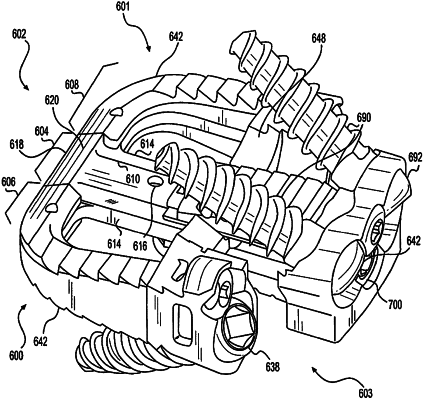| CPC A61F 2/447 (2013.01) [A61F 2/4455 (2013.01); A61F 2/4611 (2013.01); A61B 17/8042 (2013.01); A61F 2002/3008 (2013.01); A61F 2002/30131 (2013.01); A61F 2002/30242 (2013.01); A61F 2002/30331 (2013.01); A61F 2002/30372 (2013.01); A61F 2002/30448 (2013.01); A61F 2002/30505 (2013.01); A61F 2002/30507 (2013.01); A61F 2002/30537 (2013.01); A61F 2002/30593 (2013.01); A61F 2002/30604 (2013.01); A61F 2002/30677 (2013.01); A61F 2002/30733 (2013.01); A61F 2002/30772 (2013.01); A61F 2002/30785 (2013.01); A61F 2002/30787 (2013.01); A61F 2002/308 (2013.01); A61F 2002/30904 (2013.01); A61F 2/441 (2013.01)] | 18 Claims |

|
1. A vertebral implant comprising:
a plate comprising a head portion, a first extension plate, and a second extension plate, the first and second extension plates extending posteriorly from a posterior surface of the head portion, wherein the first and second extension plates are spaced from one another to define a channel therebetween;
a frame member comprising a central longitudinal member defining a lumen extending therethrough, wherein the central longitudinal member comprises a first through hole extending from a superior external surface of the central longitudinal member to an inferior external surface of the central longitudinal member and in communication with the lumen;
an actuator extending through the head portion of the plate and into the lumen of the frame member; and
a friction ring having an opening corresponding to the lumen, the friction ring being positioned between the frame member and the plate, and the actuator extends through the opening in the friction ring,
wherein movement of the actuator causes translation of the plate relative to the central longitudinal member of the frame member such that the first extension plate slides above the superior external surface of the central longitudinal member, the second extension plate slides below the inferior external surface of the central longitudinal member, and the central longitudinal member is received in the channel.
|